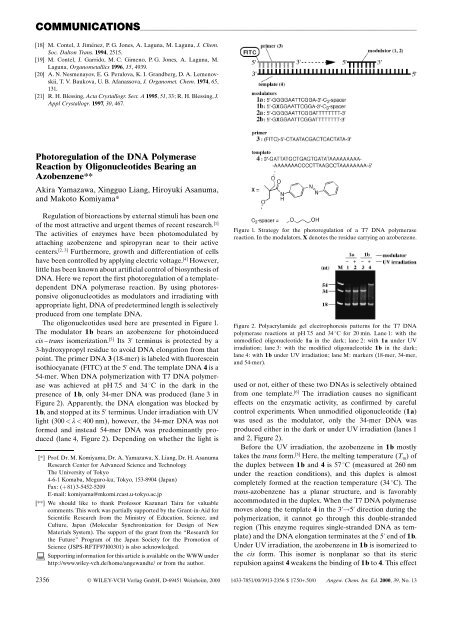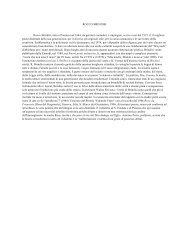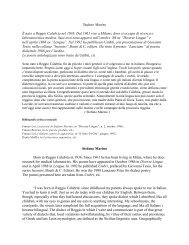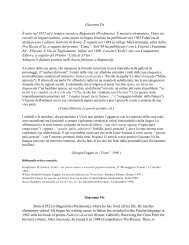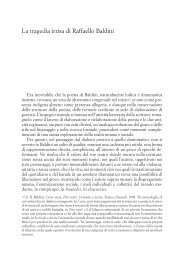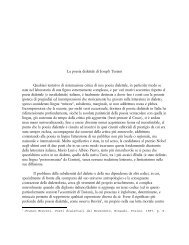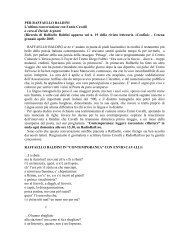A New, Simple Route to Novel Gold Clusters - Brooklyn College ...
A New, Simple Route to Novel Gold Clusters - Brooklyn College ...
A New, Simple Route to Novel Gold Clusters - Brooklyn College ...
You also want an ePaper? Increase the reach of your titles
YUMPU automatically turns print PDFs into web optimized ePapers that Google loves.
COMMUNICATIONS<br />
[18] M. Contel, J. JimeÂnez, P. G. Jones, A. Laguna, M. Laguna, J. Chem.<br />
Soc. Dal<strong>to</strong>n Trans. 1994, 2515.<br />
[19] M. Contel, J. Garrido, M. C. Gimeno, P. G. Jones, A. Laguna, M.<br />
Laguna, Organometallics 1996, 15, 4939.<br />
[20] A. N. Nesmenayov, E. G. Peralova, K. I. Grandberg, D. A. Lemenovskii,<br />
T. V. Baukova, U. B. Afanassova, J. Organomet. Chem. 1974, 65,<br />
131.<br />
[21] R. H. Blessing, Acta Crystallogr. Sect. A 1995, 51, 33; R. H. Blessing, J.<br />
Appl Crystallogr. 1997, 30, 467.<br />
Pho<strong>to</strong>regulation of the DNA Polymerase<br />
Reaction by Oligonucleotides Bearing an<br />
Azobenzene**<br />
Akira Yamazawa, Xingguo Liang, Hiroyuki Asanuma,<br />
and Mako<strong>to</strong> Komiyama*<br />
Regulation of bioreactions by external stimuli has been one<br />
of the most attractive and urgent themes of recent research. [1]<br />
The activities of enzymes have been pho<strong>to</strong>modulated by<br />
attaching azobenzene and spiropyran near <strong>to</strong> their active<br />
centers. [2, 3] Furthermore, growth and differentiation of cells<br />
have been controlled by applying electric voltage. [4] However,<br />
little has been known about artificial control of biosynthesis of<br />
DNA. Here we report the first pho<strong>to</strong>regulation of a templatedependent<br />
DNA polymerase reaction. By using pho<strong>to</strong>responsive<br />
oligonucleotides as modula<strong>to</strong>rs and irradiating with<br />
appropriate light, DNA of predetermined length is selectively<br />
produced from one template DNA.<br />
The oligonucleotides used here are presented in Figure 1.<br />
The modula<strong>to</strong>r 1b bears an azobenzene for pho<strong>to</strong>induced<br />
cis ± trans isomerization. [5] Its 3' terminus is protected by a<br />
3-hydroxypropyl residue <strong>to</strong> avoid DNA elongation from that<br />
point. The primer DNA 3 (18-mer) is labeled withfluorescein<br />
isothiocyanate (FITC) at the 5' end. The template DNA 4 is a<br />
54-mer. When DNA polymerization with T7 DNA polymerase<br />
was achieved at pH 7.5 and 34 8C in the dark in the<br />
presence of 1b, only 34-mer DNA was produced (lane 3 in<br />
Figure 2). Apparently, the DNA elongation was blocked by<br />
1b, and s<strong>to</strong>pped at its 5' terminus. Under irradiation withUV<br />
light (300 < l < 400 nm), however, the 34-mer DNA was not<br />
formed and instead 54-mer DNA was predominantly produced<br />
(lane 4, Figure 2). Depending on whether the light is<br />
[*] Prof. Dr. M. Komiyama, Dr. A. Yamazawa, X. Liang, Dr. H. Asanuma<br />
ResearchCenter for Advanced Science and Technology<br />
The University of Tokyo<br />
4-6-1 Komaba, Meguro-ku, Tokyo, 153-8904 (Japan)<br />
Fax: (‡ 81) 3-5452-5209<br />
E-mail: komiyama@mkomi.rcast.u-<strong>to</strong>kyo.ac.jp<br />
[**] We should like <strong>to</strong> thank Professor Kazunari Taira for valuable<br />
comments. This work was partially supported by the Grant-in-Aid for<br />
Scientific Researchfrom the Ministry of Education, Science, and<br />
Culture, Japan (Molecular Synchronization for Design of <strong>New</strong><br />
Materials System). The support of the grant from the ªResearch for<br />
the Futureº Program of the Japan Society for the Promotion of<br />
Science (JSPS-RFTF97I00301) is also acknowledged.<br />
Supporting information for this article is available on the WWW under<br />
http://www.wiley-vch.de/home/angewandte/ or from the author.<br />
Figure 1. Strategy for the pho<strong>to</strong>regulation of a T7 DNA polymerase<br />
reaction. In the modula<strong>to</strong>rs, X denotes the residue carrying an azobenzene.<br />
Figure 2. Polyacrylamide gel electrophoresis patterns for the T7 DNA<br />
polymerase reactions at pH 7.5 and 348C for 20 min. Lane 1: withthe<br />
unmodified oligonucleotide 1a in the dark; lane 2: with 1a under UV<br />
irradiation; lane 3: withthe modified oligonucleotide 1b in the dark;<br />
lane 4: with 1b under UV irradiation; lane M: markers (18-mer, 34-mer,<br />
and 54-mer).<br />
used or not, either of these two DNAs is selectively obtained<br />
from one template. [6] The irradiation causes no significant<br />
effects on the enzymatic activity, as confirmed by careful<br />
control experiments. When unmodified oligonucleotide (1a)<br />
was used as the modula<strong>to</strong>r, only the 34-mer DNA was<br />
produced either in the dark or under UV irradiation (lanes 1<br />
and 2, Figure 2).<br />
Before the UV irradiation, the azobenzene in 1b mostly<br />
takes the trans form. [5] Here, the melting temperature (T m)of<br />
the duplex between 1b and 4 is 578C (measured at 260 nm<br />
under the reaction conditions), and this duplex is almost<br />
completely formed at the reaction temperature (34 8C). The<br />
trans-azobenzene has a planar structure, and is favorably<br />
accommodated in the duplex. When the T7 DNA polymerase<br />
moves along the template 4 in the 3'!5' direction during the<br />
polymerization, it cannot go through this double-stranded<br />
region (This enzyme requires single-stranded DNA as template)<br />
and the DNA elongation terminates at the 5' end of 1b.<br />
Under UV irradiation, the azobenzene in 1b is isomerized <strong>to</strong><br />
the cis form. This isomer is nonplanar so that its steric<br />
repulsion against 4 weakens the binding of 1b<strong>to</strong> 4. This effect<br />
2356 WILEY-VCH Verlag GmbH, D-69451 Weinheim, 2000 1433-7851/00/3913-2356 $ 17.50+.50/0 Angew. Chem. Int. Ed. 2000, 39, No.13


